
Amputation Page Menu: 1 2 3 4 5 6 7 8 9 10 11 12 Next>>
Amputation During the Golden Age of Piracy, Page 6
The Operation
"There was no Surgeon aboard [of Captain John Phillips pirated vessel], and therefore it was advis'd, upon
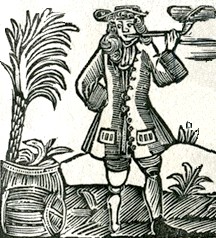
a learned Consultation, that Phillips's Leg should be cut off; but who should perform the Operation was the
Dispute, at length the Carpenter [Thomas Fern] was appointed, as the most proper Man. Upon which, he fetch'd up the biggest Saw, and taking the Limb under his Arm, fell to Work, and separated it from the Body of the Patient, in as little Time as he could have cut a Deal Board in two". (Charles Johnson, A general history of the pyrates, 3rd edition, p. 400)
While Captain Philip's pirates took the quickest route they could find to amputate (after spending some time deciding who must do the dirty dead), period surgeons had a little more precise procedure for performing this operation. Although Phillips survived the quick hacking of his leg, it probably didn't make for a very comfortable stump. So let's look at how period surgeon's chose the point of amputation and then how they proceeded with the operation. We'll also examine an alternative method of amputation first written about by a sea surgeon that foreshadowed the future of amputation.
The Operation: Choosing the Amputation Point
"The Operation resolv'd on, before the Chirurgeon applies to the Performance of it, he must first resolve on the Place where the Limb is to be taken off..." (Pierre Dionis, A course of chirurgical operations: demonstrated in the royal garden at Paris. 2nd ed., p. 407)
Each surgical author offers his own opinion of where a limb should be amputated. All agree that during amputation, you had to cut into the sound or 'good' flesh to make the amputation effective, particularly when operation was due to gangrene. Surgeons had learned that the 
John Woodall, author of the surgions mate
gangrene might extend further up inside the limb than it appeared on the outside. As John Woodall explains, "...if the occasion of dismembering proceede of a Gangrene, by reason of an inward cause, it were requisite to take the member off foure fingers above the Gangrene at the least, if the member will beare it, and let the patient have some cordiall potion..."1
Another consideration is whether they were amputating an arm or a leg. With an arm, you tried save as much of the limb as you possibly could. Ambroise Paré explains, "...if any such thing happen in the Arme... you must cut off as little of the sound part as you can."2 Pierre Dionis concurs, stating, "...if 'tis an Arm, 'tis to be cutt off as low as we can, that having the Patient a long Stump, he may make use of it, and the Deformity may not be so great as in a small one: These are the Rules of Practise which have not been contested hitherto."3 Matthias Purmann offers a dramatically different opinion: "...on the Arm, [amputation should be made] a hands breadth below the Shoulder. Higher or Lower you must not go, for there the Vessels are larger and stronger, and you cannot so easily stopt the Blood."4
There is greater debate over how much of the leg to preserve because the leg would usually be fitted with a prosthetic. Paré explains, "For the actions of the Legges much differ from these of the armes, and chiefly in this
that the body rests not, neither is carried upon the armes, as it is upon the feete or Legges."5
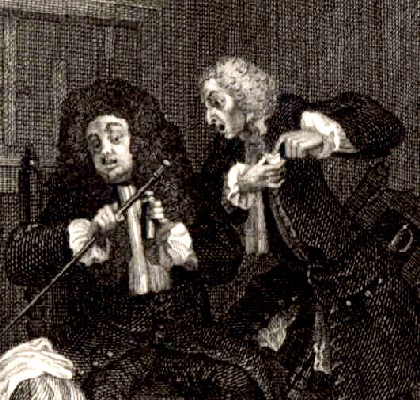
"Expires While the Doctors are Debating", Plate 6 of The Harlot's Progress
by William Hogarth (1730)
So the length of a leg amputation was more important so that it did not result in an inconvenient or painful stump once it was healed.
Woodall advises, "...that though the foote onely be corrupted, it is best to take off the legge some foure inches below the lower end of the rotule, or round the bone of the knee, the paine is all one [the same in either case], and it is most profitable to the patient, for a long stumpe were but troublesome."6 John Atkins suggests a bit more, explaining that he, "...amputated at five or six Fingers Breadth below the Knee..."7 stating in a footnote that "This Distance is most commodious for a Wooden Leg...."8 Matthias Purmann opts for a bit less than Woodall or Atkins suggesting that "The place where the Section ought to be performed, is three Fingers breadth below the Knee... I know there are several opinions in the choice of the place, but this is certainly the best, as least subject to ill Accidents and Inconviencies."9 Dionis does not use the popular 'number of fingers' measurement suggesting, "...if it a Leg, always [cut] at the gartering Place, [even] though no other Part but the Foot should be hurt to the end that we may not leave a long Stump to disturb and incommode the Patient during the rest of his Life..."10 The "gartering place" is where a garter would sit to hold up the long socks popular during this period. On me this about 3 fingers below the knee (give or take a finger), so he seems to be leaning towards the opinion of Woodall and Purmann here.
Dionis also tells us where the leg be cut off if amputation must be made above the knee, explaining "...it has obtain'd as a general rule, that if a part of the Thigh, 'tis to be cut off as near the Knee as possible..."11

Richard Wiseman, author Of Wounds, Severall Chirurgicall Treatises
Lest we leave one of the authors I have read out of this hotly debated point, let us consider Richard Wiseman's opinion. He actually agrees in the main with many of the other authors, but he also indicates that the amputation point depends in part on why amputation must be performed.
"If a Leg or Arm be shattered by Splinter or great Shot, the loss of Substance will direct you. … if the Bullet be so lodged that you cannot extract it, you shall then presently make Extirpation [amputation] of the Part. If it be the Arm, cut it off in the place where it is so shattered, and saw off the end of the Bone smooth, your Assistant the while pulling up the musculous Skin and Flesh. If the Ancle be thus maimed, you shall then cut off the Leg within three or four Fingers breadth under the Knee, in regard so long a Stump would be troublesome. But if the Leg be shattered off by the Calf, do not put your Patient to the pain of new Amputation for the shortning it a hand's breath or a little more. Save what you can of a shattered Hand. And if the Toes with part of the Foot were shot off, cut off the lacerated Parts smooth, but with care to save as much of the Foot with the Heel as you can; it being much better than a wooden Leg."12
By now you either recognize where the amputation point should be or you are completely confused. So, to summarize our period author's comments: 1) Amputations due to gangrene should be made about four inches (fingers) above the highest point of the disease. 2) The arm should be amputated at the lowest point that is above the area of damage 3) The upper leg should be amputated as close as possible to the knee and 4) The lower leg should probably be taken 3 to 4 inches (or fingers) below the knee. (Unless you decide you want to amputate lower, of course.)
1 John Woodall, the surgion's mate, p. 176; 2 Ambroise Paré, The Apologie and Treatise of Ambroise Paré, p. 149; 3 Pierre Dionis, A course of chirurgical operations: demonstrated in the royal garden at Paris. 2nd ed., p. 407; 4 Matthias Gottfried Purmann, Churgia Curiosa, p. 209; 5 Paré, p. 149; 6 Woodall, p. 175; 7 John Atkins, The Navy Surgeon, p. 130; 8 Ibid; 9 Purmann, p. 209-10; 10 Dionis, p. 407; 11 Ibid; 12 Richard Wiseman, Of Wounds, Severall Chirurgicall Treatises, p. 451-2
The Operation: The Circular Amputation Procedure
"All things thus disposed, let's now see how the Operation is to be managed." (Pierre Dionis, A course of chirurgical operations: demonstrated in the royal garden at Paris. 2nd ed., p. 410-1)
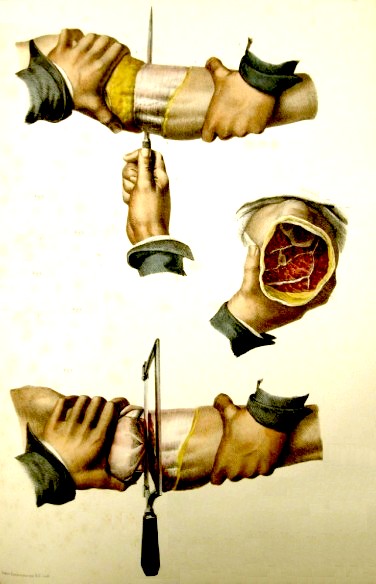
Traité complet d’anatomie de l’homme, 2nd ed.
by J.M. Bourgery, Claude Bernard, and N.H. Jacob
The operation itself is actually a pretty standard procedure according to the various surgical authors. There are some fine points, but let me try and give a succinct description of the operation using the different books to illustrate it.
By now the surgeon would have a ligature (a piece of material tied above the amputation point) serving as a tourniquet) and "...the Assistent strengthens it, whilst he draw up the Musculous flesh..."1 to pull it away from the point of amputation. "…[T]hen take your dismembering [Amputation] knife, and with a steddy hand and good speed, cut off flesh, sinewes and all, to the bone round about the member..."2 "Then with your Catling [Catlin knife - a double edged blade], divide the Flesh and Vessels about and between the Bones, and with the back of your Catling, remove the Periostrum [A tough membrane which covers a bone and is firmly attached to it] that it may not hinder the Saw, nor cause greater Torment in the Operation."3
To begin cutting through the bone(s) "...we draw the Saw gently till we find it has dented in; when we find it in the Body of the Bone. If he who holds the Leg should raise it higher at that time, he would stop the Saw, and hinder its going, for which reason he is to be directed to lower it to facilitate the Passage of that Instrument, that it may freely pass and repass without any Interruption."4 "The Saw is to be set on both Bones at once, (if two,) and divided at as few Strokes as possible, taking heed in the Division, that the nearer you come through, the easier to move, lest the Bones should splinter: If that should happen, there is a Cutting Forceps described in the Chirurgia Curiosa. Tab. II. [see image below] for proper pinching such Processes off."5

Cutting Forceps, Figure 4, Table 2, taken from Chirurgia Curiosa by Matthias Gottfried Purmann
"Fig. 4 is a Cutting Forceps necessary to punch off small Pieces or Points of Bones; its about a Span
long, made of good Steel, and very strong and sharp with a Spring, that it may always stand open
and cut with greater Force." (Purmann, p. 5)
"Where the Bone is single [in the upper arm or leg], we chuse to take a Piece of firm Cloth to hawl up the Flesh from the Saw, (the Bone proving always better covered for it:) It is made by only sliting to the Middle; the Slit falls on the Bone, and crossing the Ends underneath, you use one Hand there, the other above. In doing this, a Limb is to be kept steady and firm by an Assistant at each Hand of you..."6
Once amputated, "the seperated Part was thrown into a Vessel of Water that stood by; I placed under the Part a Pan of Ashes, to receive the Blood in amputating."7 I have also read that buckets of sawdust might be used for this purpose.
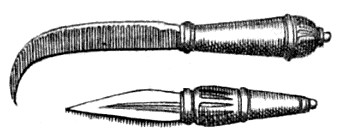
The crooked and pen knives, taken from Pierre Dionis' A course of
chirurgical operations: demonstrated in the royal garden at Paris.
2nd ed., p. 403
It is interesting (although not really very surprising) that the Amputation Knife was given several different names, as was suggested in one of the images on page 3 of this treatise. Terms (and spellings) were very malleable at this time. Woodall calls it the dismembering knife in the above quote. John Moyle also refers to to this blade as "the Dismembring Knife"8, spelling it differently (at least in this particular instance.) Matthias Gottfried Purmann names it as "a sharp crooked Incision Knife".9 Pierre Dionis refers to it as "the crooked Knife".10
Some authors suggest making the first cut (done using the Amputation Knife and cutting right to the bone) in two parts. As Moyle explains, "...you must with your dismembering Knife, take two large Slashes round the Part in the form of half rounds, and let one meet the other, as evenly as possible, and let them be deep enough."11 Dionis concurs, giving us some interesting extra details. "We then immediately take with our Right-hand the crooked Knife, which we thrust under the Leg; and fixing it on the Crista [crest or ridge] of the Tibia [large bone in the lower leg], push on the Back with our Left-hand, then descending under the Leg, and remounting by the inside till it comes to the place where we began, which makes a circular Incision, we cut all the Flesh to the bones."12 In the two-slice method, it would seem that this might result in a greater possibility of the cuts not meeting on the opposite side and would result in the surgeon having to reposition himself before beginning the second cut. (One might also imagine that the patient would be squirming a bit at this point making alignment a bit challenging.) However, this style of cutting would also seem to be easier for the surgeon. Whatever the method, John Atkins explains that "What is wanted of a compleat circular Cision, you are to supply with another Stroke of the Knife or Catlin; with which last also you are to separate the Flesh from between the Focils [the two bones of the lower arm or leg], and clear it for the Saw."13
Our surgeons provide us with some comments about the style of cutting with the Bone Saw. John Atkins suggests using "as few
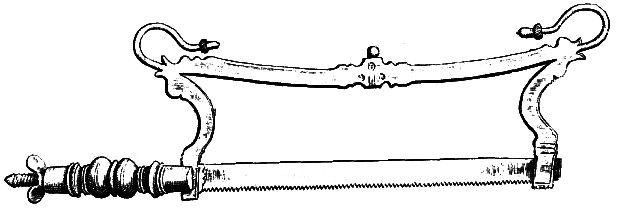
John Woodall's Drawing of a Hobb's Bone Saw, From the surgions mate, 1639 Edition, fold-out drawing
A photograph of an actual Hobb's bone saw that was auctioned can be seen on Alex Peck's Website
Strokes as possible".14 Purmann recommends using "long Stroaks, [to] cut through the Bones; but when you are almost through, use it gently to prevent the Bone from Splintering."15 Dionis explains that, "With the Saw... we do our utmost to saw the Bones with all possible Expedition, having once fix'd it on, and the Left hand laid on the Leg, we draw the Saw gently till we find it has dented in..."16
Still, these minor differences aside, the main operation was pretty standard across all the authors surveyed during the Golden Age of Piracy.
Well... almost.
1 Richard Wiseman, Of Wounds, Severall Chirurgicall Treatises, p. 452; 2 John Woodall, the surgion's mate, p. 173; 3 John Moyle, The Sea Chirurgeon, p. 52-3; 4 Pierre Dionis, A course of chirurgical operations: demonstrated in the royal garden at Paris. 2nd ed., p. 412; 5 John Atkins, The Navy Surgeon, p. 125; 6 Atkins, ibid. 7 John Moyle, Memoirs: Of many Extraordinary Cures, p. 120; 8 Moyle, Memoirs, p. 120; 9 Matthias Gottfried Purmann, Churgia Curiosa, p. 210; 10 Dionis, p. 411; 11 Moyle, Sea Chirurgeon, p. 52; 12 Dionis, p. 411; 13 Atkins, p. 125; 14 Ibid.; 15 Purmann, p. 210; 16 Dionis, p. 412

